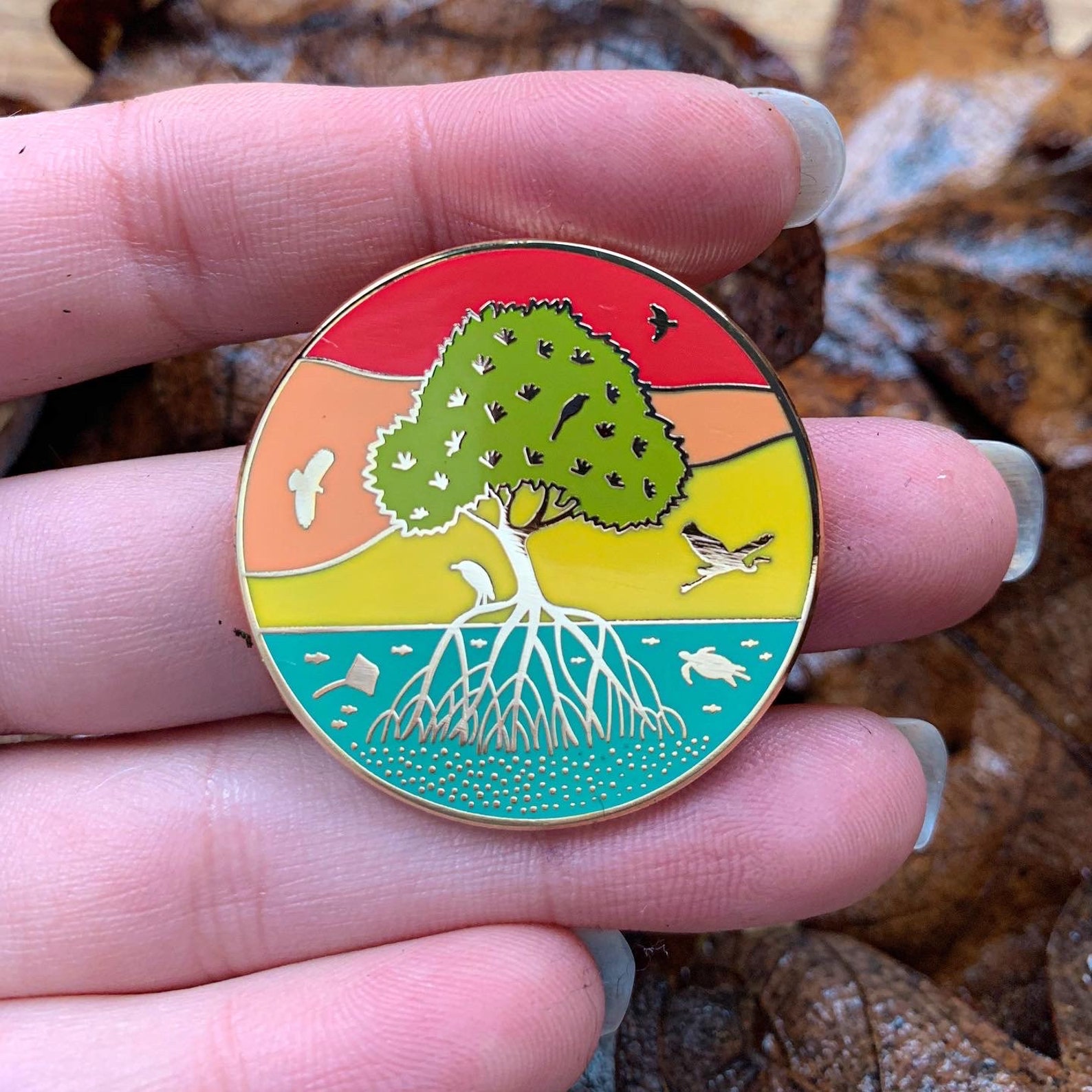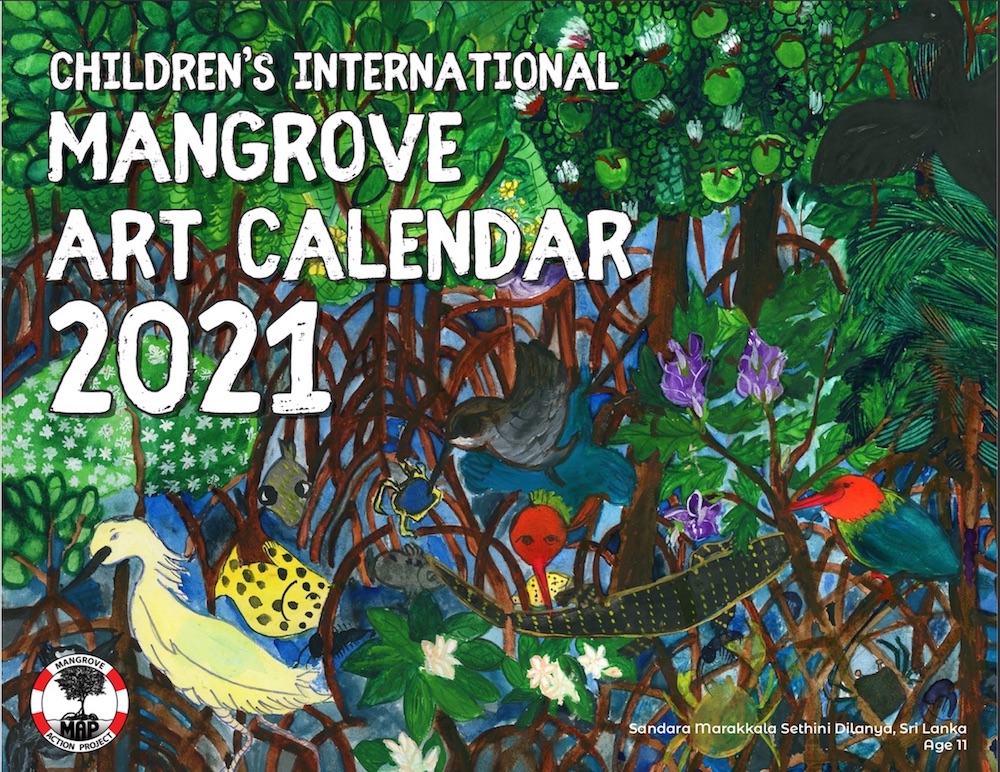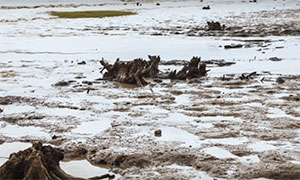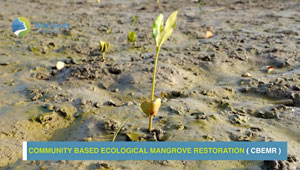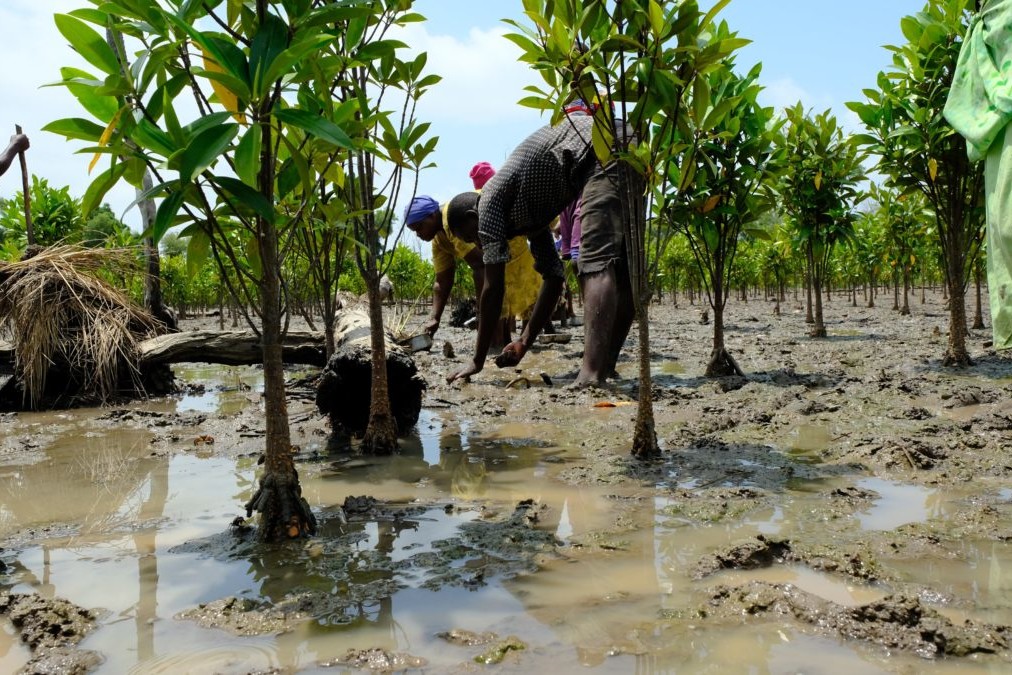|
The MAP News
515th Edition Feb 27, 2021 |
|
|
MAP and US Forest Service join together to conduct an online workshop for Pacific Island Countries  USA - As Covid-19 has grounded all face-to-face teaching activity, Mangrove Action Project (MAP) has joined together this time with the US Forest Service (USFS) International Programs to run MAP’s second online ‘community-based ecological mangrove restoration’ workshop. Running over six weeks, this workshop is designed to help the implementation of the USFS’s ‘Pacific Islands Forest Restoration Initiative’ (PIFRI) for 47 participants across Palau, Federated States of Micronesia, Solomon Islands, Vanuatu, Marshall Islands, Fiji and Samoa. The project is funded by the US State Department’s Bureau of Oceans International Environmental and Scientific Affairs. The training team consists of Dr Dominic Wodehouse, Executive Director and Jim Enright, CBEMR trainer from MAP, and Dr Richard MacKenzie, Nico Stoehr and Allison Saracina from USFS, supported by Wolf Forstreuter, USFS’s in-country consultant. READ MORE GLOBAL Mangrove: a threatened, living territory  GLOBAL - At the end of the 1990s, FAO reported the loss of 50% of this ecosystem, worldwide. The Latin American continent is undoubtedly the most affected by the destruction of the mangrove ecosystem. In the 1930s, mangrove wood was in great demand for piles and tannins, and since the end of the 1970s the main causes have been the implementation and expansion of industrial shrimp aquaculture, followed by large-scale tourism development and housing construction. The discharge of pollutants from upland areas is another threat to their conservation. The loss of food and jobs for local communities in coastal areas, which are negative consequences of mangrove destruction, are not compensated by the industrial activities that replace this ecosystem. The impoverished and precarious conditions faced by small-scale coastal fishing and harvesting communities are evident: lacking basic services, access to health and education. In the context of the COVID19 pandemic, the conditions of impoverishment of the harvesting and fishing communities in marine-coastal territories have been exposed. This historical and structural impoverishment affects all aspects of the lives of these communities and is further intensified by the restrictions imposed by governments, almost worldwide, such as confinement measures, prohibition of mobilisation, closure of workplaces. In addition to this, governments usually pay little or no attention to the health of the local people, and fail to take compensatory measures to alleviate their losses. READ MORE AFRICA EU funded mangrove management project - Ghana and eight other West Africa Nations benefit  GHANA - An integrated programme to protect the biodiversity of mangroves and other fragile ecosystems in West Africa to enhance their resilience to climate change in nine West African countries is being implemented The four-year project (2019-2023) on the “Management of Mangrove Forests from Senegal to Benin (PAPBio C1 Mangroves), seeks to protect mangroves in Ghana, Senegal,The Gambia, Sierra Leone, Benin, Guinea Bissau, Liberia, Togo and Benin. It was signed in July 2019 with €9.9 million funding from the European Union (EU) and is jointly implemented by the International Union for Conservation of Nature (IUCN),the Wetlands International Africa and the 5Deltas collective. The four priority conservation landscapes include Mono Volta (Ghana, Benin and Togo), Grand Saloum (Senegal and The Gambia), Basse Casamance (Senegal, Guinea Bissau and Guinea) and Grand Mano (Sierra Leone and Liberia). READ MORE AMERICAS Urban planning and nature-based solutions, keys for reducing flood risk in Panama 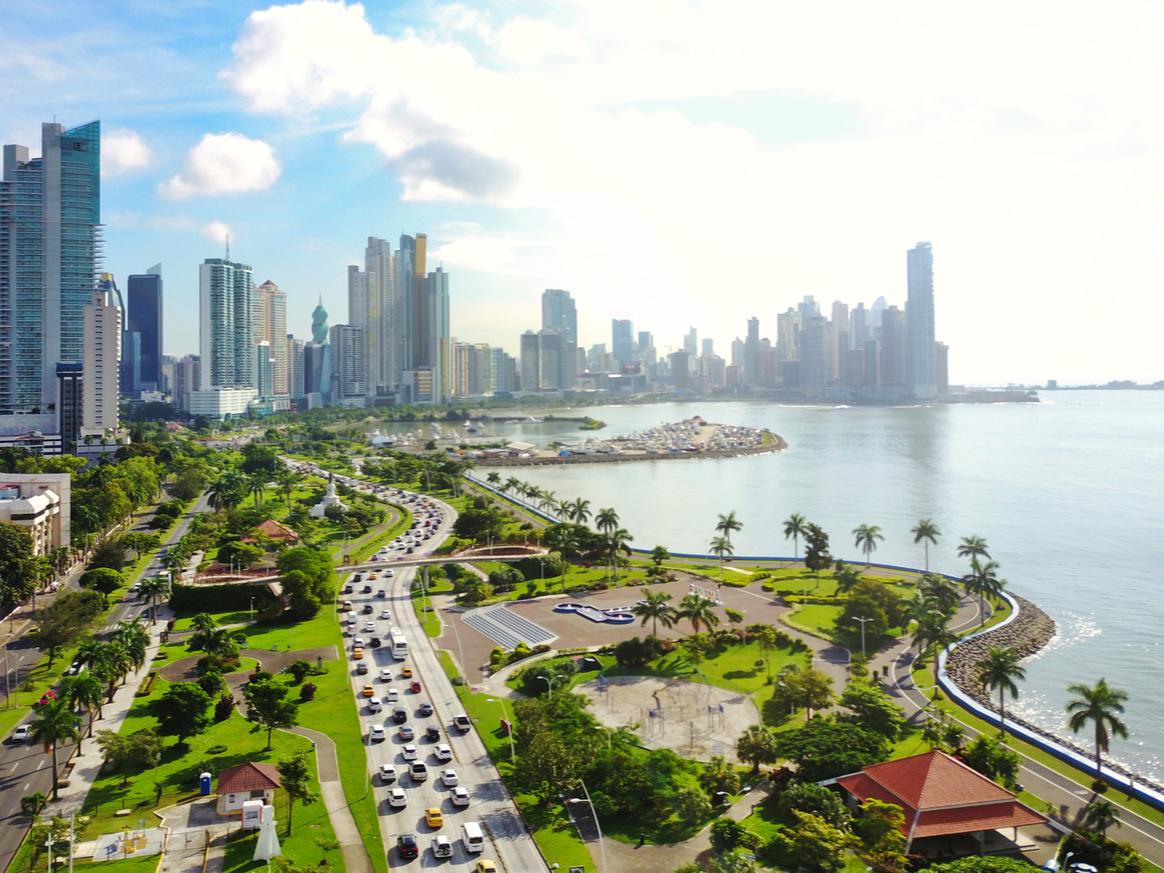 PANAMA - Panama City has tripled in size during the last 25 years as a result of rapid and unplanned urbanization. Its geographic location, combined with a lack of adequate land use planning, deficient drainage systems, and weak local governance, all make it a city highly exposed and vulnerable to the impact of floods and rising sea levels. This scenario implies a major challenge for the socio-economic development and resilience of this city of two million inhabitants. Urban expansion, characterized by landfilling and construction in mangrove areas, has aggravated the degradation and loss of the Panama Bay RAMSAR site. Mangroves play a key role in reducing floods and protecting coastlines against waves, rising sea levels, and coastal erosion. In just fifteen years, between 2000 and 2015, mangrove coverage in the Tocumen basin has been reduced by 60% . These degradation processes have caused a significant rise in the frequency and impact of floods in the watersheds and coastal areas, generating the risk conditions that have already been evidenced in other basins of the city, such as the Juan Díaz river basin. READ MORE Massive mangrove restoration projects aims to speed Bahamas recovery 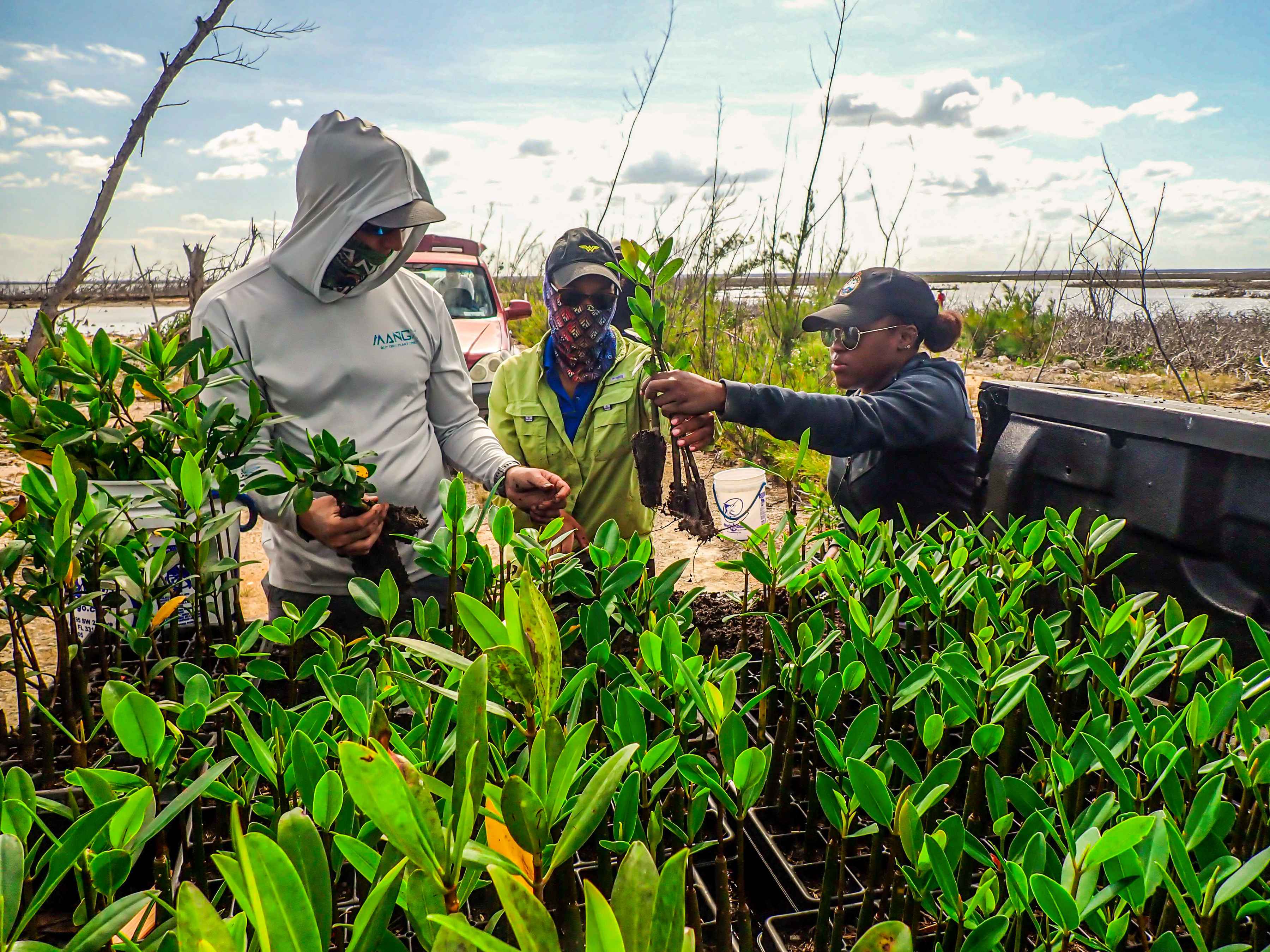 BAHAMAS - Hurricane Dorian stalled over the Bahamas in early September of 2019, thrashing the islands of Great Abaco and Grand Bahama with unrelenting winds, rain and storm surge. The devastation the storm inflicted on both islands—destroying airports, sweeping away hotels and fishing lodges, and leveling entire neighborhoods—was catastrophic and absolute. But impacts to the Bahamas from Dorian weren’t limited to its human toll. The storm also caused extensive damage to the natural environments of the hardest hit Bahamian islands. Perhaps most notable was the damage done to the ecologically crucial mangrove forests that ring the Bahamas’ islands and cays. A recent scientific survey revealed that Dorian damaged or destroyed nearly 74 percent of Grand Bahama’s and 40 percent of Abaco’s mangroves. In order to combat this damage, and speed recovery, a new mangrove restoration project is seeking to transplant as many as 100,000 mangrove seedlings to the areas hardest hit by Hurricane Dorian. READ MORE ASIA ‘Hungry’ palm oil, pulpwood firms behind Indonesia land-grab  INDONESIA - Conflicts over land flared up across Indonesia in 2020, as Indigenous and rural communities tried to hold off pulpwood, palm oil and logging companies ramping up their expansion during the COVID-19 pandemic. The flurry of activity came despite the economic slowdown wrought by the government’s response to the pandemic, and suggests the companies were taking advantage of the situation to lay claim to disputed territory, according to the Consortium for Agrarian Reform (KPA), an NGO that advocates for rural land rights. In its year-end report, the KPA recorded 138 land conflicts between April and September 2020, up from 133 in the same period in 2019. The 2019 cases occurred during a strong economy, when GDP grew by 5.01%, while the 2020 cases were recorded during Indonesia’s first recession in two decades, when the economy shrank by 4.4%. While the increase in the number of conflicts is small, it’s highly unusual, given that such cases decline during a weak economy as companies put their investment and expansion plans on hold, said KPA secretary-general Dewi Kartika. READ MORE Mangrove forests store more carbon when they're more diverse  CHINA - Mangrove forests with greater species diversity can store more carbon, according to new research published in the British Ecological Society journal Functional Ecology. Researchers studying mangrove forests in Hainan Island, China, have found that species diversity in mangrove forests enhances both biomass production (the quantity of organic matter) and soil carbon storage. The findings highlight the impotence of conserving mangrove biodiversity as a nature-based solution to mitigate climate change. The East side of the island was found to have the highest mangrove biomass, diversity and carbon storage, with a mean of 537 tonnes of carbon per hectare (Mg C ha-1). This compared to a mean of 328 Mg C ha-1 across the entire island, and the world mangrove forest mean of 386Mg C ha-1. This is the first study based on an intensive field study to verify the positive effect of biodiversity on mangrove biomass and carbon storage. Mangroves grow in tropical regions and are one of the most carbon rich ecosystems on the planet. There are over 70 different species worldwide with 27 of these in China and 26 in the areas studied by the researchers. READ MORE Maldives seeks Cusat’s help to save mangroves  MALDIVES - KOCHI: Worried over large-scale ‘die-off’ of mangrove species in several islands of, the environment ministry of the island nation has sought the scientific and technical support from marine biologists of Cochin university of science and technology (Cusat). The phenomenon which was noticed in March 2020 on11 islands, including Sh. Feydhoo, H.A. Uligan and G.Dh. Hoadedhoo, has worried Maldives as the mangroves serve as a natural protection against sea-level rise, tsunamis and sea erosion. “The Maldivian government worked with the Indian embassy there to reach out to institutions in India and when they approached us, we immediately agreed to do the study. Because of Covid-19, we couldn’t go there and instead, they have sent us samples for analysis here in our laboratory,” said Prof S Bijoy Nandan, head, department of marine biology, microbiology & biochemistry. According to the environmental protection agency (EPA) in Male, the first case was reported from H A Kelaa and H. Dh. Neykurendhoo. Maldives is a home to 15 mangrove species including the rare Bruguiera hainesii, one of the critically endangered species as per the IUCN Red List. READ MORE Before the coup, Myanmar's stunning biodiversity had a chance. Now it is not so certain 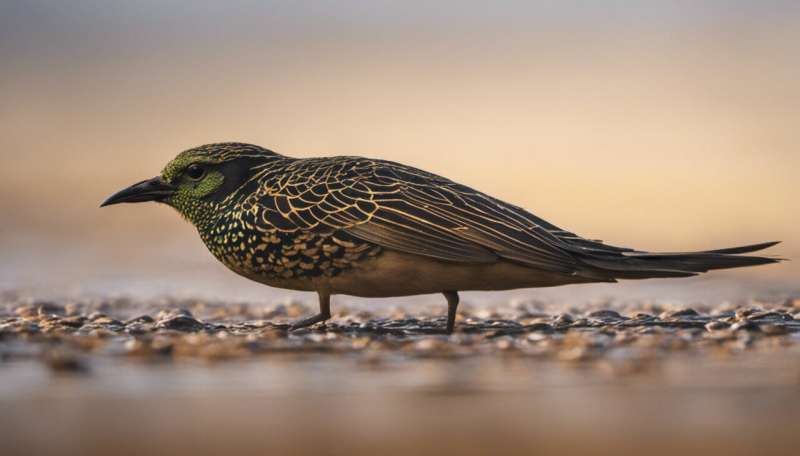 MYANMAR - The military takeover in Myanmar this month is a serious setback for democratic reform. But the coup also threatens to permanently damage the Southeast Asian nation's precious environment, and harm the people who rely on it. Myanmar is renowned as a biodiversity hotspot, and supports more than 230 globally threatened species. But the nation's natural resources have been heavily exploited in pursuit of economic growth. In particular, logging, hunting, and fishing have created serious environmental problems. The transition to civilian rule in 2011 meant conservation efforts could be deployed. It allowed researchers and practitioners such as ourselves to work in Myanmar, from the village to government level, to help manage protected areas. But the coup means this vital work may not continue. READ MORE Into a magical world–the vast Pichavaram mangroves of Tamil Nadu 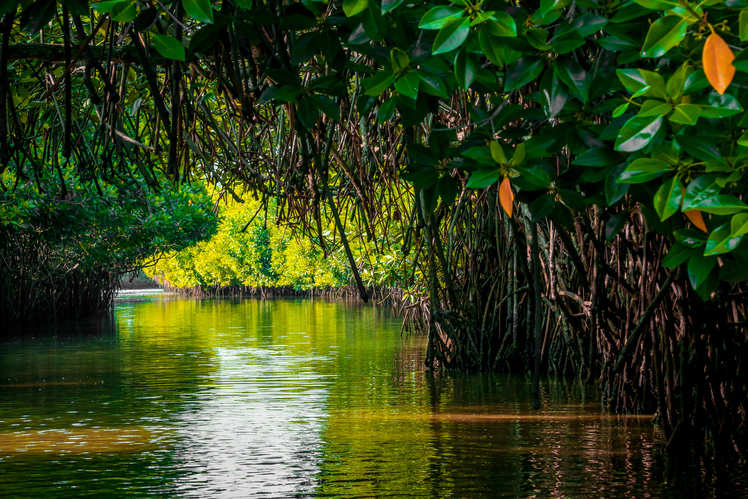 INDIA -Visiting Tamil Nadu's Pichavaram mangroves is like visiting a different world, literally. Vast expanses of big and small canals and a few islands amaze the visitors here. Silence pervades this region, barring the sound paddles, presence of chirpy birds, and gushing waters of the sea at a distance. Pichavaram mangroves, being the largest in the world, are home to 200 species of birds as well as seaweed, prawns, crabs, fish, oysters, turtles and otters. It is believed that the mangroves were originally called Thillai Vana as the rishis used to live here with their wives. Once, Lord Shiva had graced this region and performed Ananda Tandav (blissful cosmic dance) to gladden the rishis. A few popular South Indian movies have also been shot at this location. READ MORE 200 mangrove propagules planted in Nueva Valencia 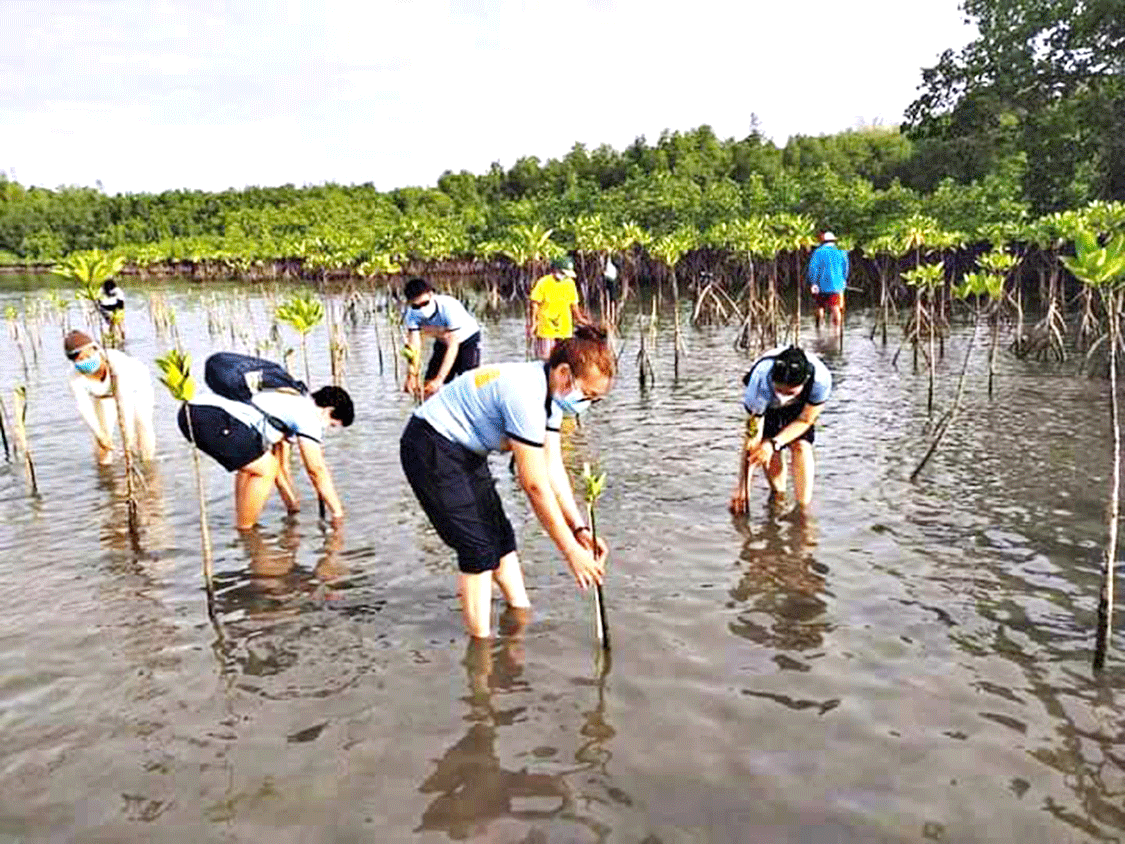 PHILIPPINES - Some 200 mangrove propagules were planted along the coast of Barangay La Paz here on Feb. 20 by personnel of the municipal government and police station. Mangrove planting is a quarterly activity of the local government. Mangrove forests are extremely productive ecosystems that provide numerous goods and services both to the marine environment and people. They are home to a large variety of fish, crab, shrimp, and mollusk species. These fisheries form an essential source of food for coastal communities. The dense root systems of mangrove forests trap sediments flowing down rivers and off the land. This helps stabilizes the coastline and prevents erosion from waves and storms. In areas where mangroves have been cleared, coastal damage from typhoons is much more severe. READ MORE Sea water supply cut off to kill mangroves 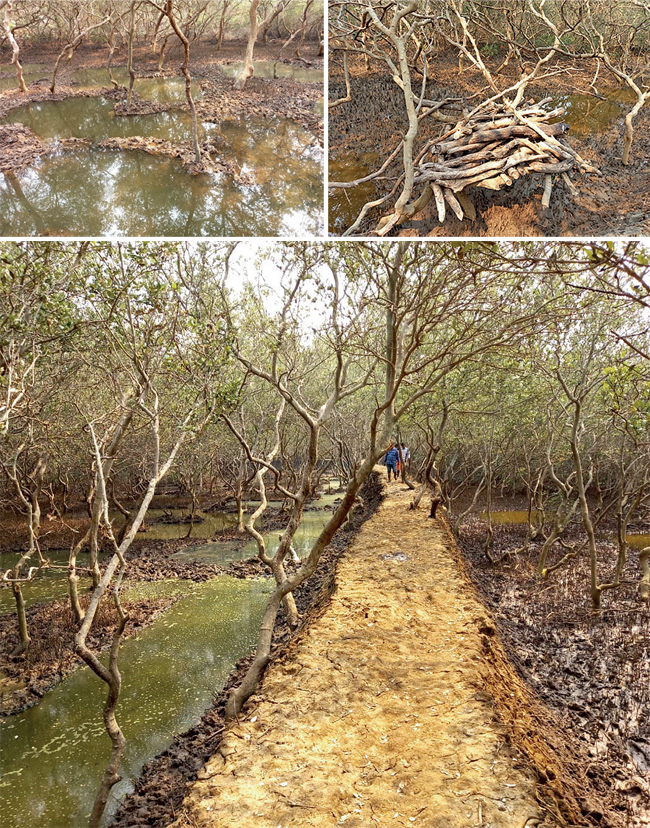 INDIA - The mangroves in Dahisar Creak, which have become fragile due to constant attacks from the land mafia, are facing a fresh threat to their existence. Harish Pandey, an environment activist working with New Link Road Residents Forum, has written to the Mangrove Protection Cell, BMC and local police that major environmental violations such as cutting of mangroves, building of bunds and blocking of sea water have been witnessed in the mangroves of Dahisar West on Government Land. The access is only from the sea and boats, he said. Pandey has asked the mangrove protection cell to immediately take corrective measures and book the culprits. READ MORE Maharashtra Government To Take Action Against People Axing Mangrove Forests  INDIA - In recent developments, Shiv Sena leader instructed the concerned authorities to take immediate steps to stop the axing of Kandal forest as well as the practice of damaging the Kandal forest by dumping debris.He further urged the authorities to create awareness among the people about the importance of Kandalvans in terms of environmental conservation i.e. measures that should be taken to build protective walls or fences in the forest, install CCTV etc. Moreover, the Shiv Sena leader also directed authorities to take action against the developers and vehicles involved in dumping debris in these mangrove forests. Moreover, two environmental groups have alleged that large tracts of mangroves are being systematically destroyed across Mumbai and nearby areas due to slow progress in handing over the coastal vegetation to the state's forest department. Meanwhile, the NGO administration stated that despite the state government asking district collectors, CIDCO and JNPT to transfer mangroves under their control to the forest department, things are not moving in the right direction. READ MORE |
URGENT ACTION
|
|
Mangrove Action Project Click here to view past newsletters
|
|
Search News Archive
Saturday, February 27, 2021
Map News Issue #515 - Feb 27, 2021
Thursday, February 25, 2021
MAP and US Forest Service join together to conduct an online workshop for Pacific Island Countries
To quote USFS, ‘Pacific Island Countries (PIC) are especially vulnerable to the effects of climate change as the remote nature of these islands has resulted in human populations that rely heavily on good and services harvested from mangroves and upland forests. PICs and their forests are already experiencing impacts from sea level rise, increased wildfires, shifts in rainfall patterns, and increased extreme weather events such as tropical cyclones or droughts. Natural hazards continue to pose a threat to the countries’ sustainable growth and economic development. These impacts are further compounded by growing rates of deforestation and forest degradation from agricultural and aquaculture conversion, infrastructure development, unsustainable logging, natural hazards and increased spread of invasive species. The independent and interactive effects of these impacts have decreased the provision of ecosystems goods and services from forested ecosystems and increased forest carbon emissions. The restoration of mangrove and upland forests is a proven management action than can help PICs adapt to the impacts of climate change, reduce forest carbon emissions, and increase the overall resilience of human communities.’
The PIFRI project focuses on awarding small grants to local NGOs and offers technical assistance in the form of trainings and workshops to to improve the quality and extend the coverage of not just the islands’ mangroves but also the terrestrial forest to ensure they continue to provide their valuable ecosystem goods and services to the local communities and wider population.
For enquiries, please contact either
richard.mackenzie@usda.gov or dominic@mangroveactionproject.org
Saturday, February 13, 2021
MAP News Issue #514 - Feb 13, 2021
|
The MAP News
514th Edition Feb 13, 2021 |
|
|
Cayman Islands Mangrove Rangers Mangrove Discovery Camp Great Success  CAYMAN ISLANDS - The Cayman Islands Mangrove Rangers launched its first Mangrove Discovery Camp in celebration of World Wetlands Day (February 2nd). The two day camp involved a series of fun hands-on activities based on the Marvelous Mangroves curriculum which has been taught in all Cayman schools for over 20 years. “The activities lead to a deeper understanding of mangrove ecosystems and the threats that they face,” explained Ranger founder Martin Keeley. During the afternoon of the second day the 20 attendees took a discovery tour of the famous Central Mangroves – at 8,500 acres the largest contiguous wetland in the Caribbean. The field trip was conducted by Sea Elements, partner in the camp. Unfortunately, the weather was too rough for the kayaks, however Mike Nelson of Sea Elements captained his launch which is specially designed for educational trips. The trip ended up with attendees checking out the starfish at Starfish Point. Rangers Daniella Christian, Dinara Perera, Javahn Syms and Kayla Young joined rangers’ co-founder Martin Keeley in running the camp which covered everything from salinity experiments to ecosystems, food chains and webs, microscopic identification and analysis of micro-organisms, to human impacts on mangroves. The activities were held at the International College of the Cayman Islands (ICCI) which generously donated the classroom facilities. READ MORE AFRICA New Partnership for Mangrove Restoration 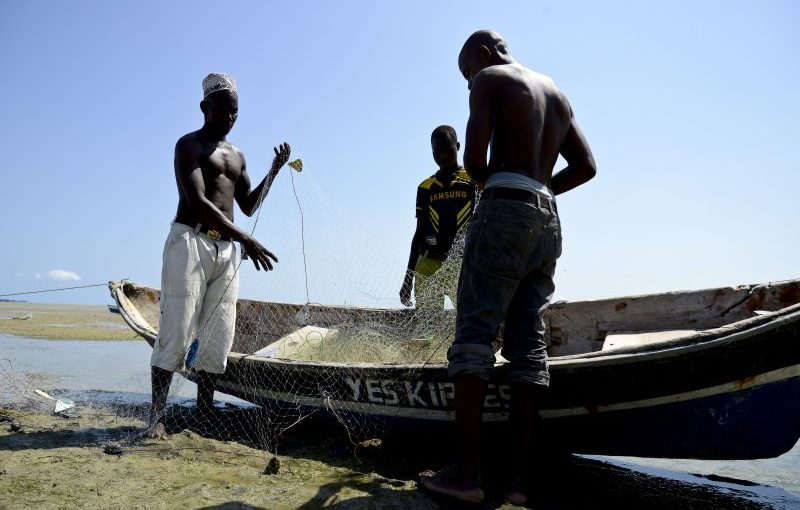 MOZAMBIQUE - he Mozambican National Institute of Fisheries Research (IIP) and the Eden Association for Reforestation signed a Memorandum of Understanding (MoU), under which the two sides agreed to work together in a mangrove restoration drive along the Mozambican coastline. The country has designed a national strategy for mangrove restoration which seeks to restore up to 5,000 hectares of mangrove forest by the year 2022. Under the existing partnership 777 hectares have been restored in Maputo, with 330 others to replant. As result of the success in Maputo, the Eden Association, with wide-ranging experience in mangrove restoration, has been trusted with the responsibility to intervene in the southern province of Inhambane, and in the Bank of Sofala, as well as other areas envisaged under the association's plan. The director of the IIP, Jorge Mafuca, said the aim is to work for the restoration of mangrove areas in the framework of the national strategy approved in 2020 by the Mozambican government. "Under this partnership, the two sides will move on to the Bank of Sofala as one of the areas with critical cases of mangrove destruction, not only because of the frequent natural disasters that have hit the region, but also because of human action," Mafuca said. READ MORE AMERICAS Costa Rica Puts Mangrove Protections at Heart of Paris Climate Commitments 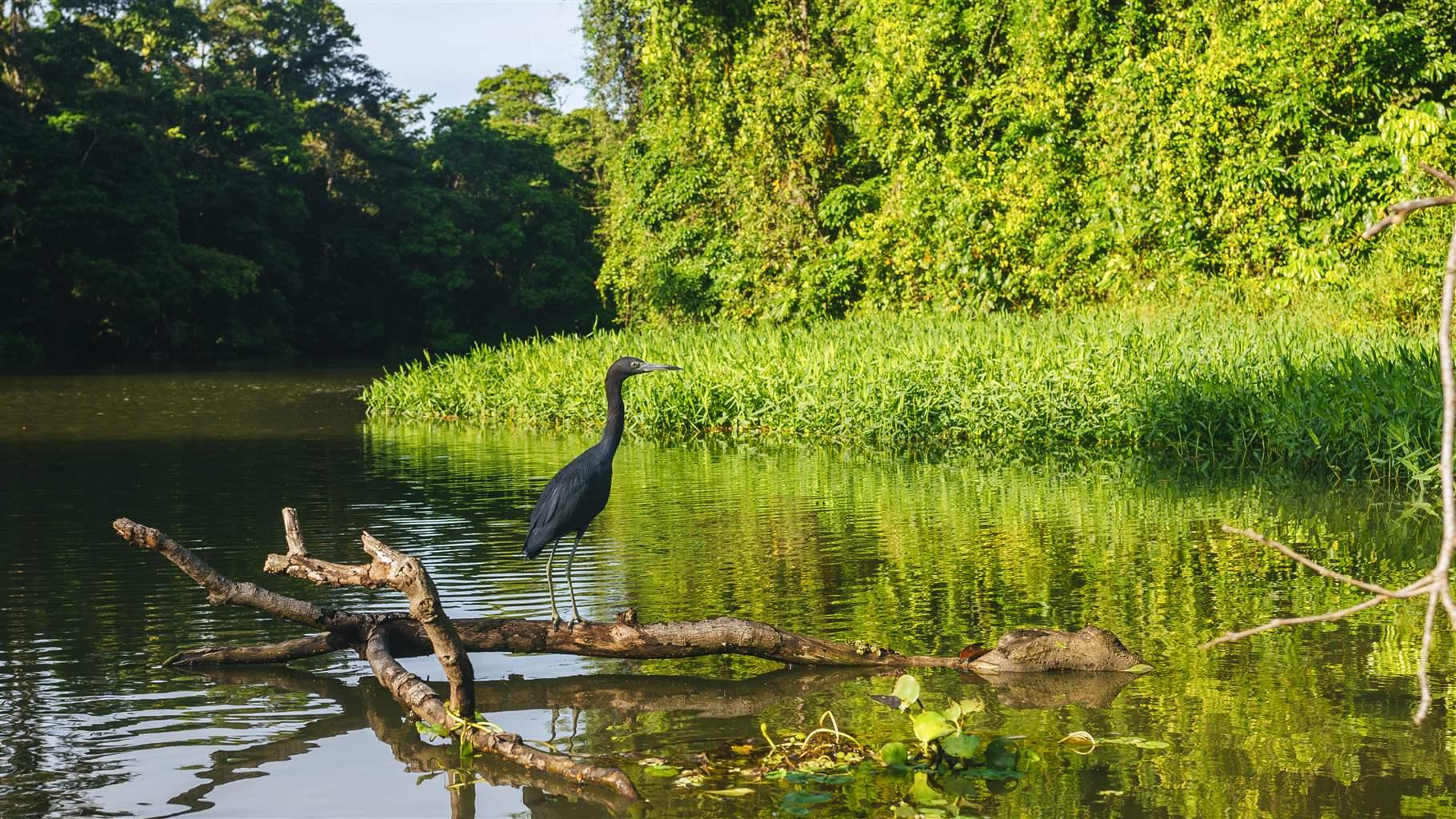 COSTA RICA - Mangroves help in the fight against climate change, as well as provide nursery and foraging grounds for many species, including birds such as this heron in Tortuguero, Costa Rica, and protect communities from storms and natural disasters. Costa Rica is one of several countries including these coastal wetlands at the heart of their commitment to the Paris Agreement. Costa Rica has a proud history of protecting its natural heritage. With more than a quarter of Costa Rica’s lands designated as national parks, an energy grid that runs on 100% renewable energy most days of the year, and a national plan to achieve net zero carbon emissions by 2050, the country has placed environmental stewardship at the core of its national identity. Underpinning this effort has been innovative planning and financing for conservation, including the country’s payment for ecosystem service (PES) program. For the past 20 years, under the PES model, the government has compensated farmers for conserving forests on their lands, thereby monetizing the valuable ecosystem services the forests provide, such as storing carbon, supporting biodiversity, and protecting communities against flooding or landslides. READ MORE In St Thomas, Kayaking Through the Mangroves  VIRGIN ISLANDS - You always have that feeling of joy,” Sybille Sorrentino says, gazing at the wall of green just across the water. “It’s a three-by-two-mile sanctuary.” We’re at Virgin Islands Eco Tours, set on the southeastern coast of the island of St Thomas, an operation that has been running kayak tours for 25 years. And from the moment you turn off Route 32, you feel it, too. Paddle a minute or two off the dock and you’ve entered the frontier; you’re no longer in St Thomas — or so it seems. This is the Mangrove Lagoon, and it’s one of the most spectacular settings in the Virgin Islands, a breathtaking natural gallery of mangroves and tiny cays abutting the ocean’s edge. And what’s wonderful how accessible it is, equally enjoyable for the novice just off Highway 32 and the advanced kayaker. READ MORE ASIA As threats increase, community’s efforts to save Pulicat lake continues  INDIA - Meerasa’s story is one of displacement. The son of a boat maker and a resident of Dhonirevu (Karimanal island), one of many villages around the Pulicat lake, Meerasa and his parents were evicted from their home in 1985 during ISRO’s Sriharikota expansion. Meerasa now lives in Jameelabad and has worked in conservation since he graduated from school. But with industrial expansion around Pulicat lake threatening the land and the mangrove forests that surround them, Meerasa fears that history might be repeating itself. About 50 km north of Chennai, Tamil Nadu, is Pulicat lake, the second largest brackish water ecosystem in India. Known as Pazhaverkadu, meaning “forest of the rooted fruit”, Pulicat lake was once covered by dense mangrove trees. But over the centuries — from mangroves being hacked for the construction of the Dutch fort in the 1600s, to the gradual clearing of forests owing to spreading urbanisation and industrial expansion — the mangroves of Pulicat have now been reduced to sporadic patches along the coast. And the mangrove destruction for industrial expansions have both severely affected biodiversity and endangered the livelihood of the fisherfolk who depend on the mangrove ecosystem. READ MORE World Wetlands Day: Construction equals destruction  INDIA - Last week India marked the World Wetlands Day with the usual pledges of protecting these crucial ecosystems safe and regenerate them. The ground reality, however, is sharply different as India leads the world in loss of wetlands, with disastrous consequences for its biodiversity. Mumbai Coastal Road and the Mumbai-Ahmedabad bullet train. Two of the most high-profile and highly controversial projects in Mumbai have one thing in common, besides extra-large budgets. Both pose severe threat to the bustling metropolis’ once thriving wetlands, which are now facing an existential crisis. The INR 1.1 trillion 508 km bullet train route linking Mumbai to Ahmedabad is likely to destroy or at least seriously impact 55,000 mangroves, the most common wetlands found in and around Mumbai. Large chunks of mangroves would be filled up for building two important railway stations, one, the terminal building in Bandra Kurla complex and the other is the Thane railway station. Even though the Maharashtra government says it is trying to reduce the impact on mangroves by realigning designs of the Thane station, the overall impact on mangroves is likely to be catastrophic, as several environmental activists have already cautioned. READ MORE Preserving Indonesia's Mangroves Crucial for Climate Change Mitigation  INDONESIA - Indonesia, which is home to one of the world’s largest mangrove forests, has set a target of rehabilitating 150,000 hectares (ha) of its area under mangroves in 2021. Based on data recorded in 2011, about three million hectares of mangrove forests can be found along 95,000 kilometers of Indonesia’s coastal areas, constituting 23 percent of the world’s mangrove ecosystem. Papua, Kalimantan, and Sumatra Islands are considered the most crucial regional mangrove ecosystems. This year’s ambitious mangrove rehabilitation program, which will be carried out particularly in critical and tsunami-prone areas, was announced by Coordinating Maritime Affairs and Investment Minister, Luhut Binsar Pandjaitan, during a recent coordination meeting held to discuss the accelerated program. READ MORE What ails Muthupet mangroves?  INDIA - Range Forest Officer A Thaheer Ali says there are multiple factors for the degradation of mangroves in the area, major ones being hypersalinity and siltation. Mangroves are salt-tolerant species and they depend on a delicate balance of fresh and seawater, and are often referred to as tidal forests. “Generally, Muthupet gets fresh water for six months, from July to December. This year, due to the extended north-east monsoon, there was flow until the second week of January. It is during the summer that the tidal water stagnates and its evaporation occurs, leading to hypersaline condition smothering the low-salt tolerant mangrove species, especially the young ones,” he said. Additionally, the six distributaries of Cauvery river – Nasuviniar, Pattuvanachiar, Paminiyar, Koraiyar, Kilaithangiar, and Marakkakoraiyar – that flush fresh water into Muthupet have silted-up. READ MORE New study to help scientists understand how mangroves thrive in desert climate 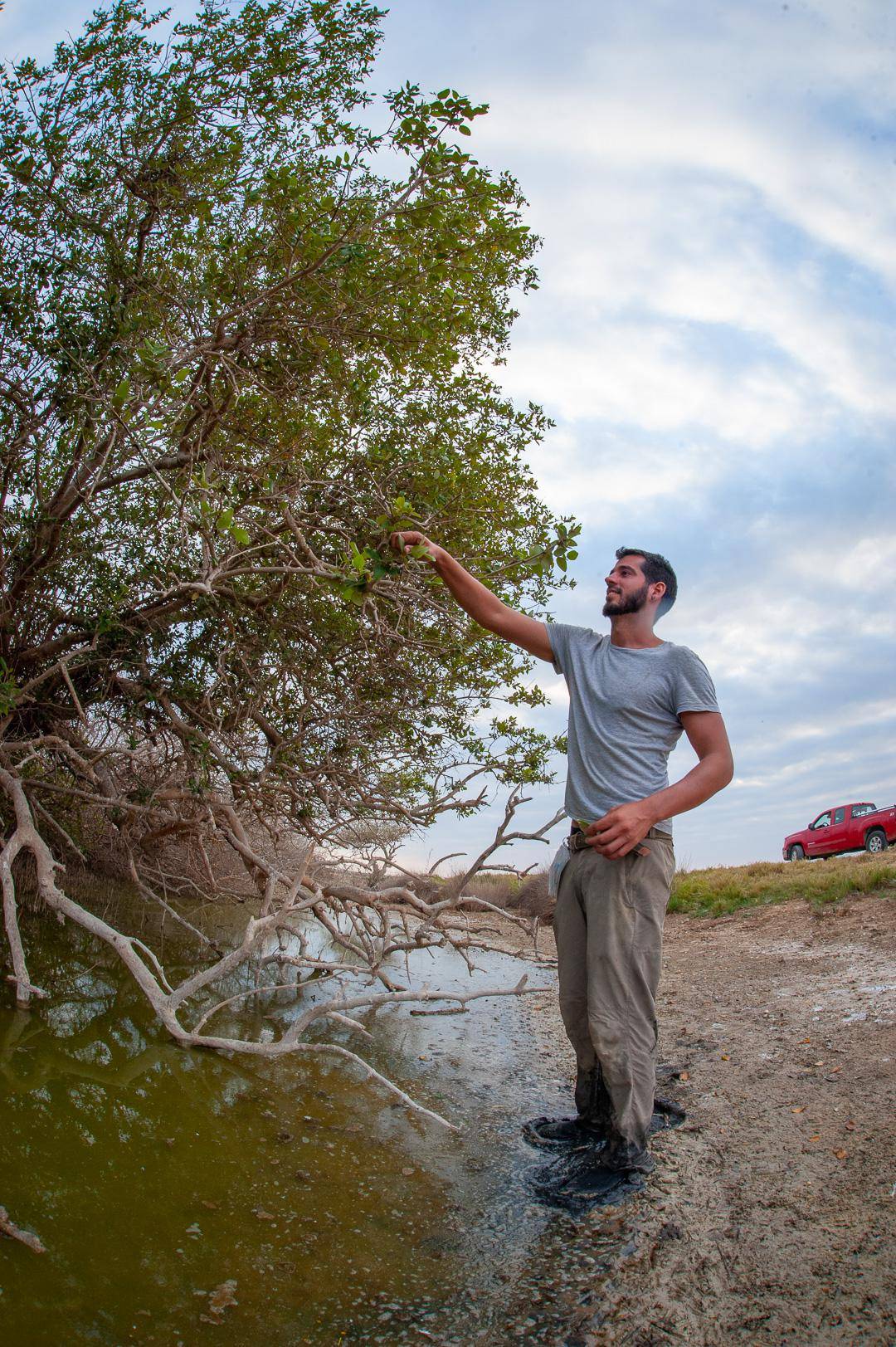 UAE - Now available to scientists across the globe, the findings will be key to understanding how these mangroves are able to thrive in the UAE, despite harsh weather conditions. The research group led by the NYU Abu Dhabi’s (NYUAD) Centre for Genomics and Systems Biology (CGSB) published the high-resolution genome for the grey mangrove (Avicennia marina) in the journal G3: Genes|Genomes|Genetics. The grey mangrove, a pan-tropical species, has a distribution that extends from New Zealand to the Arabian Gulf. As an important ‘ecosystem engineering’ species that provides habitat for many other species and protects coastlines from erosion and storm surges, there has been growing research across the globe on how these mangroves might cope with the repercussions of climate change. “The grey mangrove is the most widely distributed mangrove species in the world, and it is the only natural evergreen forest here in Abu Dhabi and across the Arabian Peninsula. This is the first highly detailed reconstruction of the genome for this mangrove, a species that is incredibly important both locally and across the tropics,” said John Burt, associate professor of biology at NYUAD and project lead. READ MORE Activist warns of mangrove destruction on CIDCO land 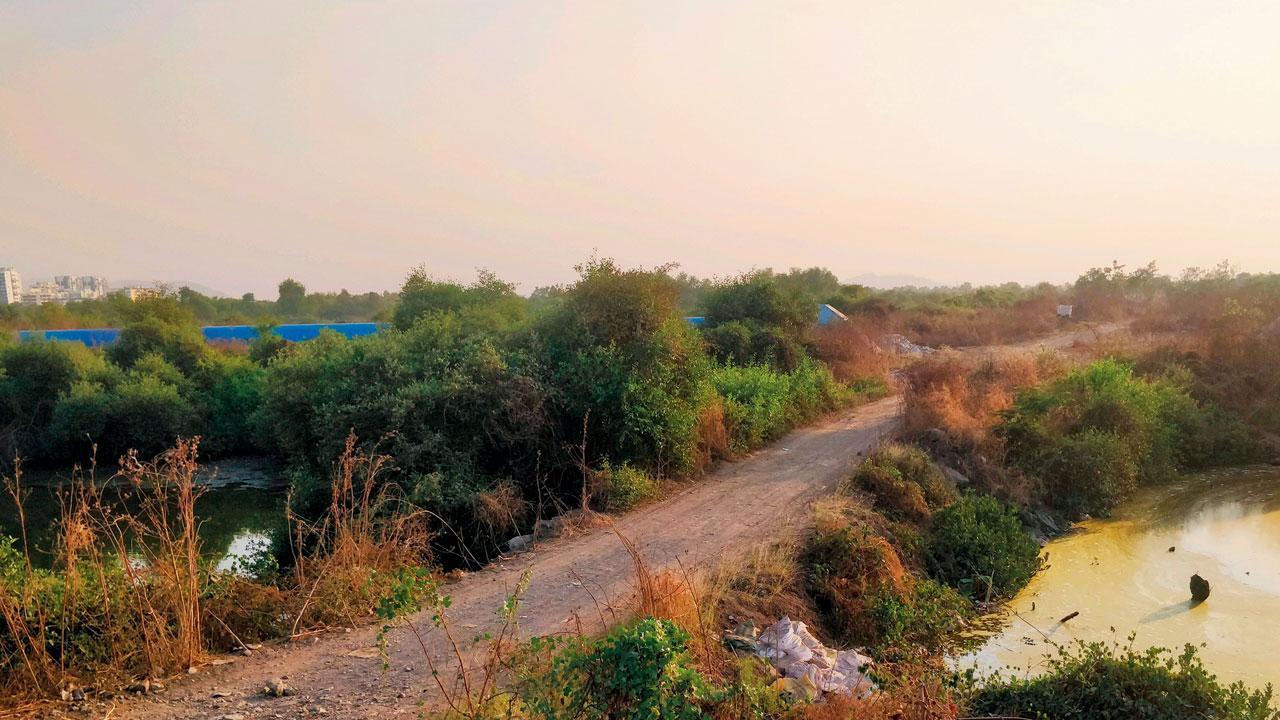 INDIA - Mangroves are being destroyed with impunity on CIDCO land at Taloja, a city-based environmentalist has alleged, insisting continued environmental violations in areas under the jurisdiction of the development body. At Taloja Phata, a kilometre-long road has been made deep into the mangroves, according to Stalin D, who has written to the Mangroves Cell of the forest department seeking concrete action. Stalin said the flow of tidal water has been blocked to the mangroves resulting in the death of many of the well-entrenched trees. He has shared GPS-tagged photos with the Cell to back his claims. “Despite clear instructions from the Mangroves Protection Committee and the Wetlands Grievance Redressal Committee directing project proponents to display boards at the sites explaining details of the work undertaken, nothing is done. Now this will be another case which will go into the records with no restoration or action taken,” reads Stalin’s letter, a copy which is with this newspaper. READ MORE LAST WORD Dear Mangrove Action Project Team, Greetings from Godrej, India. Godrej has been scientifically managing large tract of mangrove ecosystem in Mumbai city on three-pronged strategy of Research, Conservation and Awareness. The ISO 14001 certified forest hosts 16 true mangrove and mangrove associate species along with 208 bird, 82 butterfly, 81 spider, 75 insect, 31 reptile, 13 crab and 6 mammal species. Our dedicated ‘Wetland Management Department’ sensitizes 6000-8000 citizens through nature trails and several thousand more citizens through various educational resources (presentation, posters, species identification keys, story book etc.) on diversity, importance and conservation of the mangrove ecosystem through free, downloadable resources on our website. One of the key challenges in mangrove conservation is correct identification of mangrove species and inadequate understanding of the ecosystem. To resolve this challenge, and to help researchers, teachers, students, NGOs, Government agencies, nature enthusiasts, Godrej has developed a unique Mangroves mobile app. This visual and informative app describes 67 true mangrove and associate species in 11 Indian languages, including English. Users can identify mangrove species with leaf shape, flower color, scientific/common name, and location (locations are within India as of now). The app once downloaded, does not require internet connectivity, making it easy to use in field. Godrej’s mangrove app is available in Android and iOs platform here It has been downloaded in 67 countries so far, receiving appreciation and suggestions alike. The app can be easily identified with its logo of flamingo bird surrounded by mangrove leaves, crab, fish etc. May I request you to download the app and popularise in the mangrove conservation stakeholders of your country/countries you have access to? Please feel free to send your comments, suggestions using ‘Feedback’ section of the App. With your assistance, we hope more researchers, teachers, students, NGOs, Government agencies, nature enthusiasts etc will download the Mangroves app and understand the ecosystem for its conservation. Thanks and Regards Laxmikant Deshpande Godrej Construction | Godrej & Boyce Mfg. Co. Ltd. | Plant 25, Pirojshanagar,Vikhroli, Mumbai-400079, Maharashtra, India Tel: +91-22-67961097 | Mob: +91-9167344890, www.mangroves.godrej.com |
URGENT ACTION
|
|
Mangrove Action Project Click here to view past newsletters
|
|
-
The community of adults and youth in Cayman Islands has come together recently to release a series of educational videos. Each is geared to...
-
By Alfredo Quarto, Program & Policy Director Co-founder, MAP There is a rather urgent situation concerning the bio-invasion of the Son...
-
By: Isabel Robinson, MAP Volunteer Intern Some months ago I decided to come to Thailand and do an internship in mangrove conservation, ...
MAP News Issue #596 = April 20, 2024
ENTRIES NOW OPEN! Mangrove Photography Awards 2024 10 Years Celebrating Mangroves GLOBAL - MAP has launched our 10th Mangrove Photograp...



